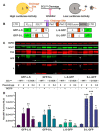Development of a Cell-Based Luciferase Complementation Assay for Identification of SARS-CoV-2 3CLpro Inhibitors
- PMID: 33498923
- PMCID: PMC7911889
- DOI: 10.3390/v13020173
Development of a Cell-Based Luciferase Complementation Assay for Identification of SARS-CoV-2 3CLpro Inhibitors
Abstract
The 3C-like protease (3CLpro) of SARS-CoV-2 is considered an excellent target for COVID-19 antiviral drug development because it is essential for viral replication and has a cleavage specificity distinct from human proteases. However, drug development for 3CLpro has been hindered by a lack of cell-based reporter assays that can be performed in a BSL-2 setting. Current efforts to identify 3CLpro inhibitors largely rely upon in vitro screening, which fails to account for cell permeability and cytotoxicity of compounds, or assays involving replication-competent virus, which must be performed in a BSL-3 facility. To address these limitations, we have developed a novel cell-based luciferase complementation reporter assay to identify inhibitors of SARS-CoV-2 3CLpro in a BSL-2 setting. The assay is based on a lentiviral vector that co-expresses 3CLpro and two luciferase fragments linked together by a 3CLpro cleavage site. 3CLpro-mediated cleavage results in a loss of complementation and low luciferase activity, whereas inhibition of 3CLpro results in 10-fold higher levels of luciferase activity. The luciferase reporter assay can easily distinguish true 3CLpro inhibition from cytotoxicity, a powerful feature that should reduce false positives during screening. Using the assay, we screened 32 small molecules for activity against SARS-CoV-2 3CLpro, including HIV protease inhibitors, HCV protease inhibitors, and various other compounds that have been reported to inhibit SARS-CoV-2 3CLpro. Of these, only five exhibited significant inhibition of 3CLpro in cells: GC376, boceprevir, Z-FA-FMK, calpain inhibitor XII, and GRL-0496. This assay should greatly facilitate efforts to identify more potent inhibitors of SARS-CoV-2 3CLpro.
Keywords: 3CLpro; COVID-19; SARS-CoV-2; antiviral; inhibitor; luciferase; protease.
Conflict of interest statement
The authors declare no conflict of interest. The funders had no role in the design of the study; in the collection, analyses, or interpretation of data; in the writing of the manuscript, or in the decision to publish the results.
Figures





Similar articles
-
Identification of non-covalent 3C-like protease inhibitors against severe acute respiratory syndrome coronavirus-2 via virtual screening of a Korean compound library.Bioorg Med Chem Lett. 2021 Jun 15;42:128067. doi: 10.1016/j.bmcl.2021.128067. Epub 2021 May 3. Bioorg Med Chem Lett. 2021. PMID: 33957246 Free PMC article.
-
Inhibitors of Coronavirus 3CL Proteases Protect Cells from Protease-Mediated Cytotoxicity.J Virol. 2021 Jun 24;95(14):e0237420. doi: 10.1128/JVI.02374-20. Epub 2021 Jun 24. J Virol. 2021. PMID: 33910954 Free PMC article.
-
Development of a Fluorescence-Based, High-Throughput SARS-CoV-2 3CLpro Reporter Assay.J Virol. 2020 Oct 27;94(22):e01265-20. doi: 10.1128/JVI.01265-20. Print 2020 Oct 27. J Virol. 2020. PMID: 32843534 Free PMC article.
-
Identifying Exifone as a Dual-Target Agent Targeting Both SARS-CoV-2 3CL Protease and the ACE2/S-RBD Interaction Among Clinical Polyphenolic Compounds.Int J Mol Sci. 2025 Mar 2;26(5):2243. doi: 10.3390/ijms26052243. Int J Mol Sci. 2025. PMID: 40076865 Free PMC article. Review.
-
A Review of the Current Landscape of SARS-CoV-2 Main Protease Inhibitors: Have We Hit the Bullseye Yet?Int J Mol Sci. 2021 Dec 27;23(1):259. doi: 10.3390/ijms23010259. Int J Mol Sci. 2021. PMID: 35008685 Free PMC article. Review.
Cited by
-
High-throughput screening assays for SARS-CoV-2 drug development: Current status and future directions.Drug Discov Today. 2021 Oct;26(10):2439-2444. doi: 10.1016/j.drudis.2021.05.012. Epub 2021 May 25. Drug Discov Today. 2021. PMID: 34048893 Free PMC article. Review.
-
High throughput screening for drugs that inhibit 3C-like protease in SARS-CoV-2.SLAS Discov. 2023 Apr;28(3):95-101. doi: 10.1016/j.slasd.2023.01.001. Epub 2023 Jan 14. SLAS Discov. 2023. PMID: 36646172 Free PMC article.
-
Viral Proteases as Targets for Coronavirus Disease 2019 Drug Development.J Pharmacol Exp Ther. 2021 Aug;378(2):166-172. doi: 10.1124/jpet.121.000688. Epub 2021 May 10. J Pharmacol Exp Ther. 2021. PMID: 33972366 Free PMC article. Review.
-
Gain-of-Signal Assays for Probing Inhibition of SARS-CoV-2 Mpro/3CLpro in Living Cells.mBio. 2022 Jun 28;13(3):e0078422. doi: 10.1128/mbio.00784-22. Epub 2022 Apr 26. mBio. 2022. PMID: 35471084 Free PMC article.
-
Design of modular autoproteolytic gene switches responsive to anti-coronavirus drug candidates.Nat Commun. 2021 Nov 22;12(1):6786. doi: 10.1038/s41467-021-27072-3. Nat Commun. 2021. PMID: 34811361 Free PMC article.
References
-
- Mulligan M.J., Lyke K.E., Kitchin N., Absalon J., Gurtman A., Lockhart S., Neuzil K., Raabe V., Bailey R., Swanson K.A., et al. Phase I/II study of COVID-19 RNA vaccine BNT162b1 in adults. Nature. 2020;586:589–593. - PubMed
Publication types
MeSH terms
Substances
Grants and funding
LinkOut - more resources
Full Text Sources
Other Literature Sources
Research Materials
Miscellaneous

